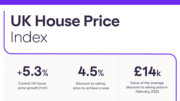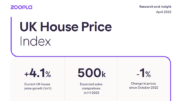UK homeowners selling detached properties have pocketed average gains of £122,500 over the past 18 months-more than quadruple the profits seen by flat sellers-according to new analysis from Zoopla. The data underscores how space, tenure, and location continue to define capital growth prospects, with landlords and investors watching closely for signals on where to deploy their next buy-to-let funds.
Detached homes deliver £122k gains
Zoopla’s figures show sellers in England and Wales made an average gain of £72,000, representing a 38% uplift from their original purchase price. Detached properties far outperformed, with average gains of £122,500, while semi-detached homes yielded £80,000, and terraced properties £64,250. Flats, by contrast, trailed behind at just £27,000, marking a meagre 15% increase.
For landlords, the lesson is clear: larger homes with gardens or space to extend remain the most resilient in value and rental appeal. As family demand for spacious rentals continues to outstrip supply, those holding detached or semi-detached buy-to-lets are sitting on both strong equity and steady rental yields.
Propertymark’s Nathan Emerson said the trend “reflects a continued imbalance between housing supply and buyer demand,” adding that “family homes with outdoor space and flexibility remain highly desirable post-pandemic.”
Long-term ownership pays
Zoopla’s data also highlights what it calls the “15-year tenure trap”. In parts of Northern England, sellers who owned their homes for 15 to 20 years made £30,000 less on average than those who sold after a 10 to 15-year period-just £45,000 compared to £75,000.
The reason? Many of these long-term owners bought at the height of the 2008 financial crisis, meaning much of their gain was swallowed by a decade of stagnant regional growth. By contrast, those who have held on for 20 years or more have bypassed that cycle entirely, with London owners cashing in £361,500 in capital gains on average-the highest in the country.
This dynamic has implications for portfolio landlords, many of whom are now considering regional diversification or equity recycling-selling long-held southern assets to reinvest in higher-yielding northern or midlands markets.
London sellers unlock £130k
Regionally, the average London seller made £130,000, while those in the South East gained £94,000, both representing a 35% rise in value. By contrast, sellers in the North East saw just £35,000, equal to a 26% uplift-but those lower values also represent some of the UK’s best rental yield potential for investors entering the market today.
The data reveals striking regional contrasts: Wales and the Midlands both posted growth of over 40%, demonstrating that percentage gains can still be strong even where total capital appreciation remains modest in cash terms.
Richard Donnell, Zoopla’s Executive Director, said: “British homeowners are sitting on sizable capital gains from years of historic house price inflation. However, the scale of those gains is unlikely to be repeated as price growth moderates.”
Donnell added that estate agents currently have “the highest stock of homes for sale in over seven years,” warning sellers that unrealistic pricing could double time-to-sell. For landlords, that slowdown presents opportunities to negotiate on larger homes offering strong long-term equity growth.
Editor’s view
Detached and semi-detached homes continue to outperform as capital growth engines, underscoring a structural divide in the market. For landlords, the takeaway is clear: the family rental sector remains both profitable and resilient, while flats and smaller units struggle against affordability limits and shifting lifestyle preferences. As market conditions normalise, strategic repositioning towards quality, space, and tenure longevity may define the next phase of buy-to-let investment success.
Author: Editorial team - UK landlord & buy-to-let news, policy, and finance.
Published: 16 October 2025
Sources: Zoopla Research 2025, Propertymark, ONS, UK Land Registry.
Related reading: Prime London second-home deals slump as new taxes deter investors








